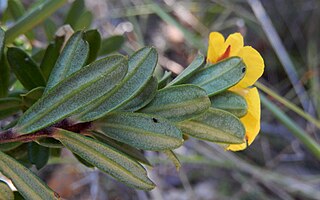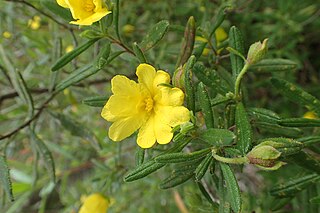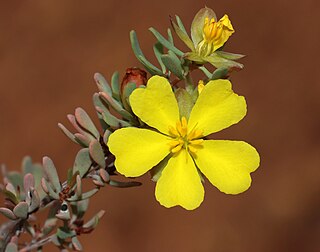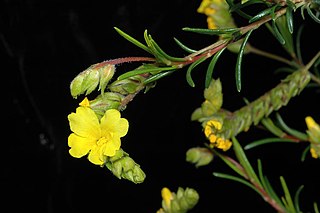
Hibbertia hypericoides, commonly known as yellow buttercups, is a species of flowering plant in the family Dilleniaceae and is endemic to the south-west of Western Australia. It is usually a spreading shrub with linear to elliptic or egg-shaped leaves, and yellow flowers, usually with ten to fifteen stamens arranged in a cluster on one side of the two densely hairy carpels.
Hibbertia marginata, commonly known as bordered guinea flower, is a species of flowering plant in the family Dilleniaceae and is endemic to the North Coast of New South Wales. It is a spreading shrub with hairy young branches, oblong to lance-shaped leaves and yellow flowers with thirty to forty stamens and many staminodes arranged around three hairy carpels.

Hibbertia bracteata is a species of flowering plant, in the family Dilleniaceae, and is endemic to eastern New South Wales. It is a shrub with lance-shaped to oblong leaves and yellow flowers with about sixteen stamens arranged on one side of the two carpels.
Hibbertia banksii is a species of flowering plant in the family Dilleniaceae and is native to Queensland and New Guinea. It is a shrub with thick, leathery leaves and yellow flowers with about twenty to forty-eight stamens arranged on one side of the two carpels.

Hibbertia desmophylla is a species of flowering plant in the family Dilleniaceae and is endemic to the south-west of Western Australia. It is a sprawling or erect, hairy shrub with spreading, densely clustered, linear leaves and yellow flowers with eleven to thirteen stamens.
Hibbertia echiifolia is a species of flowering plant in the family Dilleniaceae and is endemic to northern Australia. It is a variable shrub with elliptic to lance-shaped or oblong leaves and yellow flowers arranged singly in leaf axils, with twenty-nine to forty-five stamens arranged around the three carpels.
Hibbertia florida is a species of flowering plant in the family Dilleniaceae and is endemic to New South Wales. It is a small shrub with oblong to lance-shaped leaves and yellow flowers arranged on the ends of branchlets, with twelve to twenty-eight stamens arranged around three carpels.

Hibbertia furfuracea is a species of flowering plant in the family Dilleniaceae and is endemic to near-coastal areas of south-western Western Australia. It is an erect shrub with narrow egg-shaped leaves with the narrower end towards the base, and yellow flowers borne in upper leaf axils, with ten to twelve stamens all on one side of two carpels.

Hibbertia glomerata is a species of flowering plant in the family Dilleniaceae and is endemic to the south-west of Western Australia. It is a much-branched shrub with mostly oblong or egg-shaped to elliptic leaves and yellow flowers borne on the ends of short side shoots, with nine to twelve stamens, sometimes in groups of three, arranged around the three carpels.
Hibbertia hirsuta is a species of flowering plant in the family Dilleniaceae and is endemic to southern Australia. It is a small, slender, prostrate shrub with sparsely hairy foliage, narrow elliptic leaves and small yellow flowers with a single petal, usually only a single stamen and two carpels.

Hibbertia melhanioides is a species of flowering plant in the family Dilleniaceae and is endemic to north Queensland. It is a shrub with hairy foliage, oblong to elliptic or lance-shaped leaves, and yellow flowers with more than about 25 to 30 stamens and up to eight staminodes arranged around three carpels.
Hibbertia nemorosa is a species of flowering plant in the family Dilleniaceae and is endemic to north Queensland. It is a shrub with ridged branches, oblong leaves and yellow flowers arranged singly or in pairs in leaf axils with 40 to 48 stamens and up to eight staminodes arranged around two or three carpels.
Hibbertia nitida is a species of flowering plant in the family Dilleniaceae and is endemic to the Central Coast of New South Wales. It is an erect shrub with lance-shaped leaves with the narrower end towards the base and yellow flowers with about eleven stamens arranged on one side of two silky-hairy carpels.
Hibbertia oblongata is a species of flowering plant in the family Dilleniaceae and is endemic to northern Australia. It is an erect to spreading shrub with scaly foliage, elliptic to oblong leaves, and yellow flowers usually arranged singly in leaf axils, with 16 to 36 stamens arranged in bundles around the two carpels.

Hibbertia polystachya is a species of flowering plant in the family Dilleniaceae and is endemic to the south-west of Western Australia. It is an erect to sprawling or straggly shrub with narrow elliptic to linear leaves and yellow flowers arranged in groups of up to five with about ten stamens and a similar number of staminodes, arranged on one side of two hairy carpels.
Hibbertia porcata is a species of flowering plant in the family Dilleniaceae and is endemic to south-eastern continental Australia. It is a small, low-lying to prostrate shrub with linear leaves and yellow flowers with fifteen to twenty-five stamens arranged around three hairy carpels.
Hibbertia scabra is a species of flowering plant in the family Dilleniaceae and is endemic to the north of the Northern Territory. It is a small shrub with hairy foliage, linear to narrow elliptical leaves and yellow flowers arranged singly near the ends of branches with about fifty stamens arranged around two densely scaly carpels.

Hibbertia spicata is a species of flowering plant in the family Dilleniaceae and is endemic to the west of Western Australia. It is a low, erect to spreading shrub with scattered linear leaves with the edges rolled under and yellow flowers with six or seven stamens on one side of two softly-hairy carpels, and a larger number of staminodes.
Hibbertia ulicifolia is a species of flowering plant in the family Dilleniaceae and is endemic to the south coast of Western Australia. It is a shrub with spirally arranged, linear to awl-shaped leaves and golden yellow flowers with nine stamens fused at the bases, all on one side of two densely shortly-hairy carpels.
Hibbertia velutina is a species of flowering plant in the family Dilleniaceae and is endemic to Queensland. It is a shrub with foliage covered with rosette-like hairs, elliptic leaves, and yellow flowers with thirty to thirty-six stamens arranged in bundles around two densely scaly carpels.









